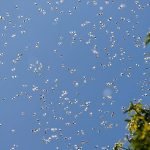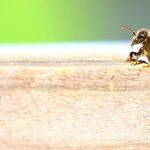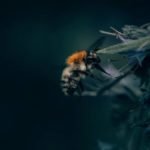Why are bees clustering at the hive entrance? There are a number of answers to this question – depending on which answer it depends on if we do nothing, or immediately work on the hive! Let us have a look at what a big “bee beard” on the hive means and how we can work out what to do if we need to do anything.
Why Are Bees Clustering At The Hive Entrance?
There are a number of potential reasons why bees are clustering at the hive entrance. Here are the main ones.
Day Time Cluster
If you note bee behavior at the hive entrance during the day, where the bees will cluster and form a big mass of bees, you will need to use the following diagnostic.
Is The Weather Warm Or Even Hot – 80°F Or More?
Why are bees clustering at the hive entrance when it is hot? If the weather is hot, the bees will sometimes cluster outside the hive because it gets too hot inside the hive. If there is a honey flow on, and the bees are doing this, you can give them a bit more space – add a super for more honey and bee space.
If there is not a honey flow on, and it is very hot, look at things you can do to keep the sunlight off the cluster of bees – bees are dark and absorb heat. A cluster in the sun gets cooked by the sun and becomes an angry cluster in the sun. I often used to place a sheet of corrugated iron against the side of the hive that faced away from the sun – these clusters of bees will go and hide in the shade cast by the corrugated iron.
Is The Weather Mild and Cool, But Spring Is Approaching?
Why are bees clustering at the hive entrance when it is mild or cool in spring? This form of entrance clustering happens often in spring – the hive population increases rapidly and as the bees prepare to swarm, there will often not be enough space in the hive. You can requeen the hive, and put on supers to give them more space. This can stop a swarm. Or you can split the hives – this allows you to increase the number of hives you have.
Nighttime Clusters
Why are bees clustering at the hive entrance at night? I actually like to see bees clustering at the hive entrance at night. I manage my hives to always have a small night cluster at the entrance during spring, summer, and fall. Naturally, you don’t want a cluster at the entrance in winter as they will freeze and die.
More often than not, a strong hive will have a big field force of workers that go out to forage on flowers each day. These workers will not all be able to fit in the hive at night. The advantage of a big cluster on the entrance of the hive at night is that it makes it more difficult for predators/humans/pests to irritate the hive.
If you plan to migrate bees, and there is a big cluster on the hives at night, it is a good idea to place an empty super on top of the last super on the hives and place the lid on top of that. This will cause the cluster to enter the hive and you will lose a lot fewer bees when you move the hive. It is also horrible picking up hives that have clusters on them -these bees get angry and sting a lot.
Bee Behavior At The Hive Entrance
From the above few diagnostics, we have a bit more understanding of what is going on at the hive entrance. As you work more with bees there are naturally thousands of different permutations of every option that will be unique to your area. The above are a useful starting point set of guidelines to help you work out how to manage things and figure out why your bees are clustering at the hive entrance. You can fine-tune this.
We have mentioned swarms, and clusters and this may lead you to a few questions. I will try to answer a few of these now.
What Time Of Day Do Bees Swarm?
It sounds quite silly to say this, but bees do things by the clock. At different times of the year, they tend to swarm at different times of the day. When bees swarm they will normally fly out of the hive and go and cluster on a tree or bush close to the hive. From here they will reorganize, and the next day they will fly away, normally at least a few miles or more, and find a nice site to scout and look for a new nesting site.
I find that bees tend to leave the hive to swarm at the warmest time of day. Read more about the time of day bees swarm here.
A little swarm hanging in my garden. Bees will always manage to find the most irritating, thorny, difficult corner to go and hang in a swarm! Here they are hanging in the only thorny plant in my garden. This plant is known in the local language as a “Wait a bit tree” – when you walk into it, the thorns hold you and you have to “Wait a bit” while you untangle yourself. I caught the swarm – and lost my shirt.
How Do You Know When A Bee Is Swarming?
You will know when a bee is swarming when it is flying with a cloud of other bees! A swarm is a very distinctive thing, and walking in a swarm is a magical experience. I have often run inside swarms, and jogging along with the bees and watching them flying in formation around you is quite amazing. They do not sting much when swarming, so the experience is just of being one with a swarm.
You will notice if you jog to the front of a slow-moving swarm that there is a V of bees that appear to be flying with their scent glands (Nasanov’s Glands) operating, and I assume this is to guide the other bees. As you move back in the swarm you will find the bees just sort of bob around in the air and try to keep at a constant pace. I have found that in the middle you often find a small cloud of drones and I assume the queen is in there sometimes too. I have seen her a few times and she scoots around in the swarm and is quite jumpy.
Swarms do a thing after they have flown for a mile or two at ground level where they suddenly pull together and just accelerate and leave. It is a bit like Star Trek and the warp drive. You are jogging along with the bees and suddenly they pull together and “boom” they are gone. Absolutely amazing experience that I hope you get to see in your life.
It sounds silly, but there is an incredible energy in a swarm – a swarm is probably one of the most optimistic things that 50 000 animals can do all at once. They abandon a perfectly good home, fly an incredible distance and make a new home.
If we look at a bee, its body length, and the distance a swarm can move in a day, it is the equivalent of you and 49 999 other people moving 2000 miles – in an hour – then finding a spot to build a new city that day, moving into it the next day, and in one month running your city at a profit. We just don’t compete with bees in efficiency, but we can learn a lot!
In the above two videos, you can see me taking a video from the inside of a moving swarm, and then in the next video they had settled on a bush and I placed them in a box. No stings.
If you enjoyed this article please share! I hope you now know some answer to the question “Why are bees clustering at the hive entrance?” And more importantly, I hope you have a life goal of jogging with a swarm – and if you can do that, please record it!! I did that in the days before we had amazing cameras.

Dr. Garth A. Cambray is a Canadian/South African entrepreneur and beekeeper with 28 years of experience in apiculture and specializes in adding value to honey. His Ph.D. research developed a new advanced continuous fermentation method for making mead that has resulted in a number of companies globally being able to access markets for mead. His company, Makana Meadery, exports honey mead to the USA where it is available to discerning connoisseurs. He has also developed technologies to commercially manufacture organic honey vinegar in Zambia for export globally. He holds a few patents globally in the ethanol industry and believes in technology and knowledge transfer for human development and environmental sustainability. One of his proudest achievements is the fact that the wind farm he started at one of his old apiary sites has essentially made his hometown carbon neutral.







